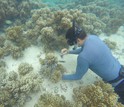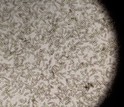News Release 17-043
Bacteria living in marine sponge produce toxic compounds found in man-made products
Finding puts researchers closer to understanding human health implications of additives that make materials flame retardant

Scripps Institution of Oceanography scientists study marine sponges in the waters off Guam.
May 11, 2017
This material is available primarily for archival purposes. Telephone numbers or other contact information may be out of date; please see current contact information at media contacts.
Researchers have discovered for the first time that a common marine sponge hosts bacteria that specialize in the production of toxic compounds nearly identical to man-made fire retardants, a finding that could help scientists better understand the human health implications of these common additives.
The new findings, by scientists at the Scripps Institution of Oceanography (SIO) at the University of California, San Diego, moved the research team a step closer to unraveling the mysteries of this powerful group of chemical compounds, known as polybrominated diphenyl ethers (PBDEs).
The National Science Foundation's (NSF) Division of Ocean Sciences and the National Institute of Environmental Health Sciences (NIEHS) of the National Institutes of Health jointly funded the research through SIO's Center for Oceans and Human Health.
"For many years scientists have been finding clues that suggested nature was making these compounds," said SIO marine chemist Brad Moore, a senior author of the study. "Now that we understand how they are produced in the marine environment, we are exploring why they exist, and the human health concerns associated with them."
The results, which appear in the May issue of the journal Nature Chemical Biology, came from a unique collaboration among chemists and biologists at SIO and elsewhere.
"This study is a powerful combination of chemical, biological and environmental research," said Henrietta Edmonds of NSF's Division of Ocean Sciences. "It has the potential to help us understand the production, fate and health consequences of natural and pollutant compounds in the marine environment."
Manufacturers add PBDEs to foam, textiles, electronics and other products to make them less flammable. These industrial chemicals are powerful endocrine disruptors that mimic the activity of the human body's most active thyroid hormone.
Vinayak Agarwal, a researcher at SIO, picked up a cold case first started nearly 50 years ago by SIO chemist John Faulkner, an early pioneer in the study of natural products from the sea. Agarwal continued Faulkner's investigation into the source of toxic PDBEs, found in large quantities in the world's oceans.
"For the first time we were able to conclusively show that genes and enzymes produced in bacteria from sponges are responsible for the production of these compounds toxic to humans," said Agarwal, co-first author of the paper along with Scripps researcher Jessica Blanton.
In 2014, Agarwal and colleagues were the first to discover that unrelated free-living marine bacteria produce the fire retardant compounds naturally.
In the new study, researchers employed two modern-day techniques -- genome "mining" and environmental DNA sequencing -- to take the investigation a step farther and identify the specific genes and enzymes involved in the overproduction of the toxic molecules in sponges.
Marine sponges obtain food and oxygen by filtering seawater through the pores and channels in their bodies. This constant flow of water means that these immobile animals host many bacteria, viruses and fungi in their complex microbiomes.
The research team collected 18 sponge samples for the study during two research expeditions to Guam. They then isolated the various components in the complex mixture of organisms from the sponge's tissues to identify the specific genes and enzymes that code for the production of PBDEs.
The genome "mining" approach along with metagenomic sequencing gave the scientists a way to connect the natural chemicals produced by organisms back to the enzymes that constructed them.
"We care about naturally produced PBDEs because they end up in the food chain," said NIEHS's Frederick Tyson. "Preliminary data from this research team suggest that some naturally occurring PDBEs may be even more toxic than those that are man-made, so we need to develop a better understanding of these compounds."
The next step in the investigation is to mine the genes and enzymes in other marine species to found out what other organisms are making similar toxic compounds and why.
Co-authors from SIO include Sheila Podell, Michelle Schorn, Julia Busch, and Paul Jensen. Researchers Arnaud Taton and James Golden from UC San Diego's Division of Biological Sciences, Jason Biggs from the University of Guam's Marine Laboratory, Zhenjian Lin and Eric Schmidt from the University of Utah, and Valerie Paul from the Smithsonian Marine Station also contributed to the study.
-NSF-
-
Researchers at the University of Guam sample sponges off Guam's coast.
Credit and Larger Version -
Researchers collect marine specimens such as this sponge and bring them back to the lab for study.
Credit and Larger Version -
Bacteria inside sponges and other marine animals produce toxic substances.
Credit and Larger Version -
Scripps Institution of Oceanography researchers Brad Moore (left) and Vinayak Agarwal in the lab.
Credit and Larger Version -
Vinayak Agarwal of the Scripps Institution of Oceanography looks at bacteria in marine sponges.
Credit and Larger Version
Media Contacts
Cheryl Dybas, NSF, (703) 292-7734, email: cdybas@nsf.gov
Robert Monroe, SIO, (858) 534-3624, email: scrippsnews@ucsd.edu
Related Websites
NSF Grant: Scripps Center for Oceans and Human Health: https://www.nsf.gov/awardsearch/showAward?AWD_ID=1313747&HistoricalAwards=false
The U.S. National Science Foundation propels the nation forward by advancing fundamental research in all fields of science and engineering. NSF supports research and people by providing facilities, instruments and funding to support their ingenuity and sustain the U.S. as a global leader in research and innovation. With a fiscal year 2023 budget of $9.5 billion, NSF funds reach all 50 states through grants to nearly 2,000 colleges, universities and institutions. Each year, NSF receives more than 40,000 competitive proposals and makes about 11,000 new awards. Those awards include support for cooperative research with industry, Arctic and Antarctic research and operations, and U.S. participation in international scientific efforts.
Connect with us online
NSF website: nsf.gov
NSF News: nsf.gov/news
For News Media: nsf.gov/news/newsroom
Statistics: nsf.gov/statistics/
Awards database: nsf.gov/awardsearch/
Follow us on social
Twitter: twitter.com/NSF
Facebook: facebook.com/US.NSF
Instagram: instagram.com/nsfgov





